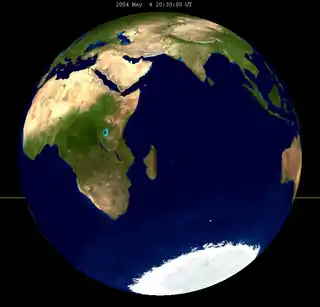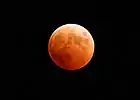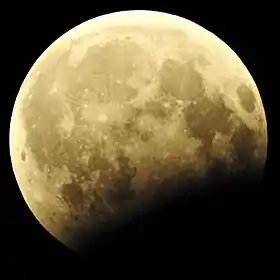October 2004 lunar eclipse
A total lunar eclipse took place on October 28, 2004, the second of two total lunar eclipses in 2004, the first being on May 4, 2004.[1] It was the first lunar eclipse to take place during a World Series game,[2][3] which when seen from Busch Memorial Stadium in St, Louis, Missouri, provided a surreal sight on the night the Boston Red Sox won their first World Series in 86 years to end the Curse of the Bambino. Occurring 5.6 days before apogee (Apogee on Tuesday, November 2, 2004), the Moon's apparent diameter was smaller. The moon was 10.1 days after perigee and 5.6 days before apogee.
| Total eclipse | |||||||||||||||||
 By Fred Espenak at 3:03 UT, from Dunkirk, Maryland | |||||||||||||||||
| Date | 28 October 2004 | ||||||||||||||||
|---|---|---|---|---|---|---|---|---|---|---|---|---|---|---|---|---|---|
| Gamma | 0.28465 | ||||||||||||||||
| Magnitude | 1.30814 | ||||||||||||||||
| Saros cycle | 136 (19 of 72) | ||||||||||||||||
| Totality | 80 minutes, 29 seconds | ||||||||||||||||
| Partiality | 218 minutes, 42 seconds | ||||||||||||||||
| Penumbral | 353 minutes, 52 seconds | ||||||||||||||||
| |||||||||||||||||
Visibility
This eclipse was completely visible from all of North and South America, and visible from most of Europe and Africa.

Relation to other lunar eclipses
Eclipses of 2004
Lunar year series
It is the third of four lunar year cycles, repeating every 354 days.
| Lunar eclipse series sets from 2002–2005 | ||||||||
|---|---|---|---|---|---|---|---|---|
| Descending node | Ascending node | |||||||
| Saros Photo |
Date View |
Type Chart |
Gamma | Saros Photo |
Date View |
Type Chart |
Gamma | |
| 111 | 2002 May 26 |
penumbral |
1.1759 | 116 | 2002 Nov 20 |
penumbral |
-1.1127 | |
121 |
2003 May 16 |
total |
0.4123 | 126 |
2003 Nov 09 |
total |
-0.4319 | |
131 |
2004 May 04 |
total |
-0.3132 | 136 |
2004 Oct 28 |
total |
0.2846 | |
| 141 | 2005 Apr 24 |
penumbral |
-1.0885 | 146_(cropped).jpg.webp) |
2005 Oct 17 |
partial |
0.9796 | |
| Last set | 2002 Jun 24 | Last set | 2001 Dec 30 | |||||
| Next set | 2006 Mar 14 | Next set | 2006 Sep 7 | |||||
Saros series
This eclipse is a part of Saros cycle 136, and the first of the series that passes through the center of Earth's shadow. The next occurrence will be on November 8, 2022. Solar Saros 143 interleaves with this lunar saros with an event occurring every 9 years 5 days alternating between each saros series. The greatest eclipse will occur on April 21, 2293, lasting 101 minutes and 23.5 seconds. The last total lunar eclipse will be on July 7, 2419 and the last partial lunar eclipse on October 3, 2563. The final lunar eclipse of Lunar Saros 136 will be on June 1, 2960.
Metonic series
This eclipse is the third of four Metonic cycle lunar eclipses on the same date, October 28–29, each separated by 19 years:
The metonic cycle repeats nearly exactly every 19 years and represents a Saros cycle plus one lunar year. Because it occurs on the same calendar date, the earth's shadow will in nearly the same location relative to the background stars.
| Metonic events: May 4 and October 28 | |
|---|---|
| Descending node | Ascending node |
|
|
 |
 |
Half-Saros cycle
A lunar eclipse will be preceded and followed by solar eclipses by 9 years and 5.5 days (a half saros).[4] This lunar eclipse is related to two solar eclipses of Solar Saros 143.
| October 24, 1995 | November 3, 2013 |
|---|---|
 |
 |
Photo gallery
 Timelapse photo from Hayward, California
Timelapse photo from Hayward, California Ault Field, Washington, 2:29 UT
Ault Field, Washington, 2:29 UT.jpg.webp) Dunkirk, Maryland, 3:03 UT
Dunkirk, Maryland, 3:03 UT From Kiuruvesi, Finland, 3:21 UT
From Kiuruvesi, Finland, 3:21 UT.jpg.webp) Seattle, Washington
Seattle, Washington
End of totality, 3:43 UT.jpg.webp) Bellevue, Washington, 3:51 UT
Bellevue, Washington, 3:51 UT.jpg.webp) Timelapse photo from A Coruña, Spain
Timelapse photo from A Coruña, Spain
See also
- List of lunar eclipses and List of 21st-century lunar eclipses
- May 2003 lunar eclipse
- November 2003 lunar eclipse
- May 2004 lunar eclipse
Notes
- Hermit Eclipse: Saros cycle 136
- Shaughnessy 2005, pp. 225–226
- Shaughnessy, Dan (October 28, 2004). "YES!!!: Red Sox complete sweep, win first Series since 1918". The Boston Globe. p. A1. Retrieved June 20, 2011.
- Mathematical Astronomy Morsels, Jean Meeus, p.110, Chapter 18, The half-saros
External links
- NASA
- Total Lunar Eclipse of Oct. 27, 2004
- 2004 Oct 28 chart: Eclipse Predictions by Fred Espenak, NASA/GSFC
- Saros series 136
- NASA Astronomy Picture of the Day: Red Moon Triple (29 October 2004)
- NASA Astronomy Picture of the Day: Pumpkin Moon (30 October 2004)
- Lunar Eclipse gallery
- Photo by Wade B Clark Jr. near Lyman, Washington, USA
- Spaceweather.com: Lunar eclipse gallery
| Wikimedia Commons has media related to Lunar eclipse of 2004 October 28. |

